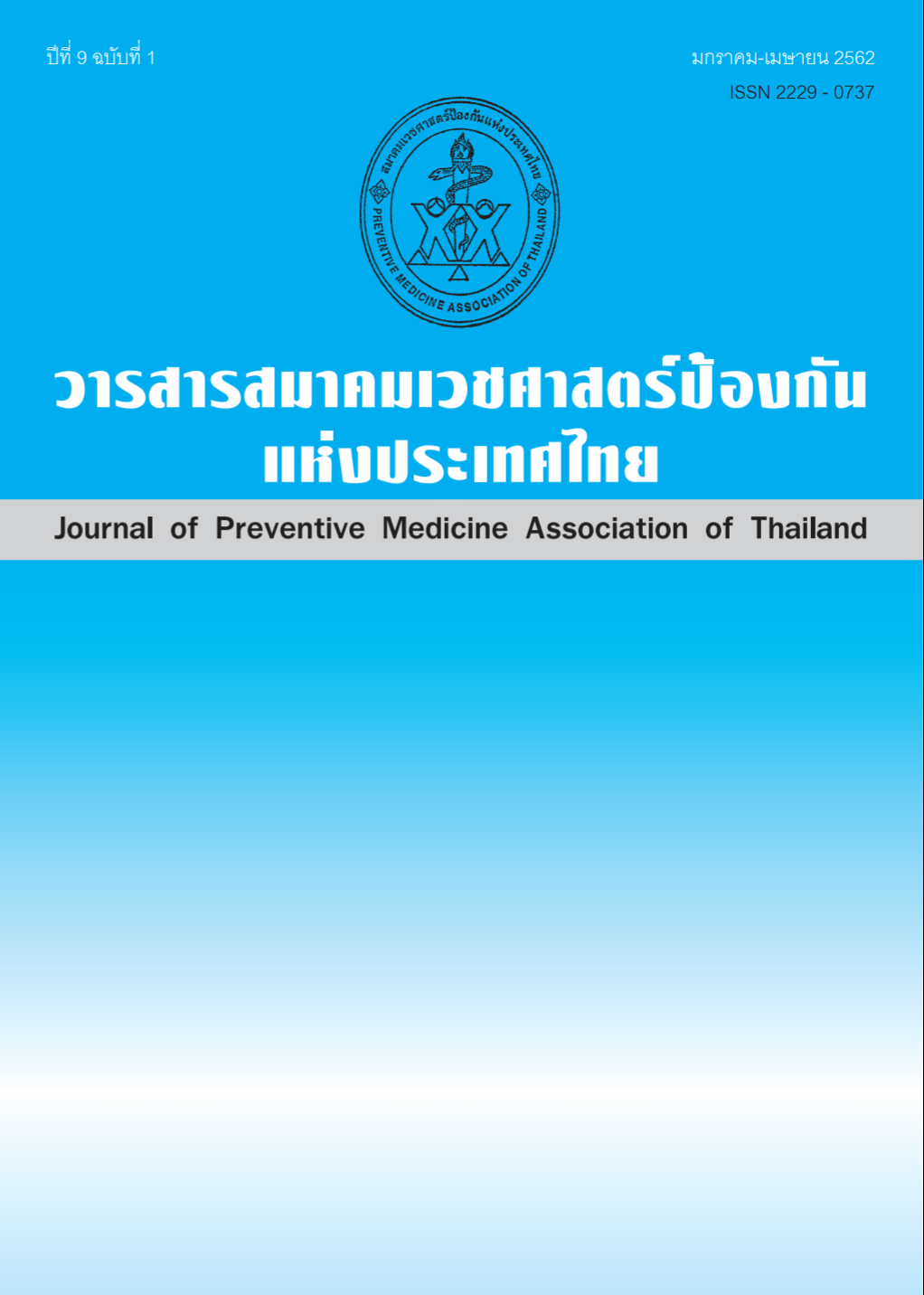Prevalence and Associated Factors of Frozen Shoulder Among Patients at Family Practice Medicine Center in Phra Nakhon Si Ayutthaya Hospital
Keywords:
Frozen shoulder, prevalence, associated factorsAbstract
Frozen shoulder or adhesive capsulitis of shoulder is a common disease in clinical practice. Clinical presentation can be varied from shoulder pain to limited range of motion of shoulder. Limited range of motion may persist despite the full course of treatment and worsen quality of life in patients. This study aimed to investigate the prevalence and associated factors of frozen shoulder among patients at Family Practice Medicine Center in Phra Nakhon Si Ayutthaya Hospital, Phra Nakhon Si Ayutthaya province. A cross-sectional study was conducted in 224 patients, who visited Family Practice Medicine Center in Phra Nakhon Si Ayutthaya Hospital from October to December 2018. Data were collected by face-to-face interview using standardized questionnaire. The questionnaire consisted of personal information, medical history and physical examination by doctors to identify frozen shoulder. The data were analyzed by using descriptive statistics and logistic regression statistics. The p<0.05 was considered statistically significant. The results found that the prevalence of frozen shoulder was 13.4%. There were 7 factors that had statistically significant association with frozen shoulder: Age 51-60 years old (CRUDE OR 13.43 [95%CI;
1.72, 105.06]), Age more than 60 years old (CRUDE OR 16.79 [95%CI; 2.04, 138.20]), Income less than 15,000 baht (CRUDE OR 4.79 [95%CI; 1.76, 13.05]), Diabetes Mellitus (CRUDE OR 2.49 [95%CI; 1.11, 5.58]), Hyperlipidemia (CRUDE OR 2.75 [95%CI; 1.26, 5.99]), Hypertension (CRUDE OR 2.99 [95%CI; 1.35, 6.65]), Shoulder pain (CRUDE OR 28.8 [95%CI; 8.36, 99.27]), Lack of shoulder exercise (CRUDE OR 6.37 [95%CI; 2.14, 18.93]). These data will help doctors to be highly aware of frozen shoulder with patients who have associated factors so as to prevent and improve quality of life for patients at Family Practice Center in Phra Nakhon Si Ayutthaya Hospital in long term care.
References
2. Cadogan A, Mohammed KD. Shoulder pain in primary care: frozen shoulder. Journal of Primary Health Care 2016;8:44-51.
3. Kelley MJ, McClure PW, Leggin BG. Frozen shoulder: evidence and a proposed model guiding rehabilitation. J Orthop Sports PhysTher 2009;39:135-48.
4. Dias R, Cutts S, Massoud S. Clinical Review: Frozen Shoulder. BMJ. 2005;331:1453-6.
5. Salek AK, Mamun MA, Haque MA, Mannan M, Ali E, Islam S, et al. Serum triglyceride level in type 2 diabetes mellitus patients with or without frozen shoulder. Bangladesh Med ResCounc Bull 2010;36:64-7.
6. Li W, Lu N, Xu H, Wang H, Huang J. Case control study of risk factors for frozen shoulder in China. Int J Rheum Dis 2015;18:508-13.
7. Hand C, Clipsham K, Rees JL, Carr AJ. Long-term outcome of frozen shoulder. J Shoulder and Elbow Surg 2008;17:23-6.
8. Milgrom C, Novack V, Weil Y, Jaber S, Radeva-Petrova DR, Finestone A. Risk factors for idiopathic frozen shoulder. Isr Med Assoc J 2008;10:361-4.
9. Reeves B. The natural history of the frozen shoulder syndrome. Scand J Rheumatol 1976;4:193-6.
10. Sung CM, Jung TS, Park HB. Are serum lipids involved in primary frozen shoulder? A case-control study. JBJS Am 2014;96:1828-33.
11. D’Orsi GM, Via AG, Frizziero A, Oliva F. Treatment of adhesive capsulitis: a review. MLTJ 2012; 2:70-8.
12. Van den Hout WB, Vermeulen HM, Rozing PM, Vliet Vlieland TP. Impact of adhesive capsulitis and economic evaluation of high-grade and low-grade mobilisation techniques. Aust J Physiother 2005;51:141-9.
13. Buchbinder R, Youd JM, Green S, Stein A, Forbes A, Harris A, et al. Efficacy and cost-effectiveness of physiotherapy following glenohumeral joint distension for adhesive capsulitis: a randomized trial. Arthritis Rheum 2007;57:1027-37.
14. Arm strong A, Hubbard M. Essentials of musculoskeletal care. 5th ed. American Academy of Orthopaedic Surgeons; 2016.
15. Binder AI, Bulgen DY, Hazleman BL, Roberts S. Frozen shoulder: a long-term prospective study. Ann Rheum Dis 1984;43:361-4.
16. Lundberg BJ. The frozen shoulder. Clinical and radiographical observations. The effect of manipulation under general anesthesia. Structure and glycosaminoglycan content of the joint capsule. Local bone metabolism. Acta Orthop Scand 1969; Suppl.119:1-59.
17. Ulusoy H, Sarica N, Arslan S. The efficacy of supervised physiotherapy for treatment of adhesive capsulitis. Bratisl Lek Listy 2011;112:204-7.
18. Malavolta EA, Gracitelli MEC, Ribeiro Pinto GM, Freire da Silveira AZ, Assunção JH, Ferreira Neto AA. Asian ethnicity: a risk factor for adhesive capsulitis?. Rev Bras Ortop. 2018;53:602-6.
19. Harkness EF, Macfarlane GJ, Nahit ES, Silman AJ, McBeth J. Mechanical and psychological factors predict new onset shoulder pain: A prospective cohort study of newly employed worker. Occup Env Med 2003;60:850-7.
20. Van der Windt D, Thomas E, Pope DP, de Winter AF, Macfarlane GJ, Bouter LM, et al. Occupational risk factor for shoulder pain: A systematic review. Occup Env Med 2000;57:433-42.
21. Tighe CB, Oakley WS Jr. The prevalence of a diabetic condition and adhesive capsulitis of the shoulder. South Med J 2008;101:591-5.
22. Austin DC, Gans I, Park MJ, Carey JL, Kelly JD 4th. The association of metabolic syndrome markers with adhesive capsulitis. J Shoulder Elbow Surg 2014;23:1043-51.
23. Lo SF, Chu SW, Muo CH, Meng NH, Chou LW, Huang WC, et al. Diabetes mellitus and accompanying hyperlipidemia are independent risk factors for adhesive capsulitis: A nationwide population-based cohort study (version 2). RheumatolInt 2014;34:67-74.
24. DePalma AF. Loss of scapulohumeral motion (frozen shoulder). Ann Surg 1952;135:193-204.
Downloads
Published
How to Cite
Issue
Section
License
บทความที่ลงพิมพ์ในวารสารเวชศาสตร์ป้องกันแห่งประเทศไทย ถือเป็นผลงานวิชาการ งานวิจัย วิเคราะห์ วิจารณ์ เป็นความเห็นส่วนตัวของผู้นิพนธ์ กองบรรณาธิการไม่จำเป็นต้องเห็นด้วยเสมอไปและผู้นิพนธ์จะต้องรับผิดชอบต่อบทความของตนเอง






